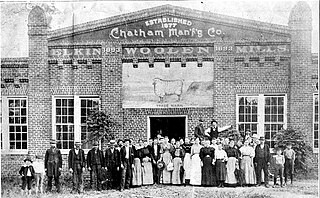
Chatham Manufacturing Mill was built by the Chatham Manufacturing Company. The former textile mill is located in Winston-Salem in North Carolina.
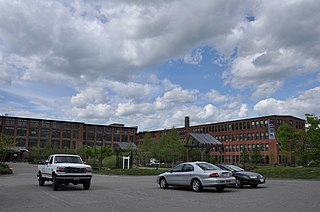
The Parkhill Mill is an historic mill complex at 1 Oak Hill Road in Fitchburg, Massachusetts. Built between 1885 and 1915, it was one of three mill complexes of the Parkill Company, one of the city's largest employers of the period. The mill complex was added to the National Register of Historic Places in 2008. The complex has been restored and is used by a variety of public and private businesses, and as residential space.

The F. A. Whitney Carriage Company Complex Historic District encompasses a major 19th-century industrial complex off 124 Water Street in Leominster, Massachusetts. The complex is one of the best-preserved in the city, and was developed by of its most successful businesses of the late 19th and early 20th centuries. The F. A. Whitney Company, founded in 1858, manufactured baby carriages and related products, and operated here from 1862 to 1952, and was one of the city's major employers. The oldest surviving buildings of its manufacturing complex date to 1872. The district was listed on the National Register of Historic Places in 1988. Most of the complex has been converted into residential use.
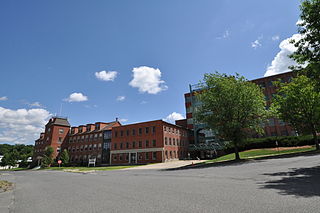
The Eaton, Crane & Pike Company Factory, once the Terry Clock Company Factory is a historic former factory complex in Pittsfield, Massachusetts. Developed over a period of years between 1883 and 1967, the complex was home to one of Pittsfield's major paper concerns, and a significant local employer. Now converted to mixed residential and light industrial use, it was listed on the National Register of Historic Places in 1990.

The Weis Manufacturing Company, currently known as WoodCraft Square, is a former factory located at 800 West 7th Street in the city of Monroe in Monroe County, Michigan. It was listed as a Michigan Historic Site and added to the National Register of Historic Places on October 26, 1981.
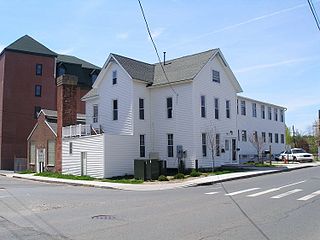
The Ball and Roller Bearing Company, also known as American Family Crafts and the Joseph Nutt House and Machine Shop, is a historic industrial complex at 20-22 Maple Avenue in Danbury, Connecticut. Developed mainly in the early 20th century, the factory is most notable as the location where Lewis Heim invented the modern grinding machine, which revolutionized the manufacture of machine parts. The complex was listed on the National Register of Historic Places on August 25, 1989. It now houses a church and social service agencies.
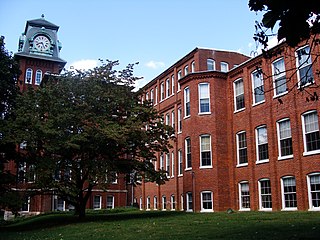
The Hamilton Watch Complex is a former industrial complex in Lancaster, Pennsylvania. It was owned by the Hamilton Watch Company and was used as their headquarters from its founding in 1892 until 1980. The complex was listed on the National Register of Historic Places in 1982. The main building was converted into a luxury apartment and condominium complex, while the Administrative Offices are now home to a Montessori school called "New School Montessori."

The H. J. Heinz Company complex, part of which is currently known as Heinz Lofts, is a historic industrial complex in the Troy Hill neighborhood of Pittsburgh, Pennsylvania. The buildings were built by the H. J. Heinz Company from 1907 through 1958. The complex is listed on the National Register of Historic Places (NRHP) and five of the buildings are listed as a Pittsburgh History and Landmarks Foundation Historic Landmark.

Market Square is a furniture showroom complex in High Point, North Carolina, owned by International Market Centers which is the largest building in North Carolina on the National Register of Historic Places (NRHP), and the sixth largest in the United States. Known also as Tomlinson Chair Manufacturing Company Complex, it was listed on the NRHP under that name. The former manufacturing complex includes the oldest factory building in the city, and its renovation has been credited with making High Point a successful furniture exhibition center. A 16-story addition in 1990 is one of the city's tallest buildings.

The Franklin Falls Historic District is a 75-acre (30 ha) historic district encompassing most of the civic and industrial heart of Franklin, New Hampshire, which saw its most significant development in the second half of the 19th century and the first decades of the 20th. The district is focused on Central Street between two crossings of the Winnipesaukee River, and includes Odell Park along with industrial properties along the bend in the river north of those two crossings, as well as a number of properties on adjacent streets south of Central Street. The district was listed on the National Register of Historic Places in 1982.

The Page Belting Company Mills is a historic mechanical belt mill complex at 26 Commercial Street in Concord, New Hampshire, United States. Located north of Concord's central business district near Horseshoe Pond, the complex consists of four brick buildings built between 1892 and 1906 for one of the city's major businesses. The mill complex, now converted to residential and other uses, was listed on the National Register of Historic Places in 2002.

The Hoyt Shoe Factory is a historic factory complex at 470 Silver Street and 170 Lincoln Street in Manchester, New Hampshire. It consists of two once-identical four-story brick factory buildings which face each other across Silver Street. Built in the 1890s, they housed the city's largest shoe manufacturer, an industry that gained in significance as its textile industry declined. The complex was listed on the National Register of Historic Places in 1985.

Oakdale Cotton Mill Village is a historic textile mill, mill village, and national historic district located at Jamestown, Guilford County, North Carolina, United States. The district encompasses 37 contributing buildings including the Logan Manufacturing Company complex built during the 1880s and 33 frame mill worker houses dated to the early-20th century. The factory complex consists of a three-story rectangular brick office, a one and two-story L-shaped brick factory with a four-story tower and five one-story brick warehouses, a small one-story board-and-batten blacksmith shop, and a polygonal brick smokestack.

Former Parks-Cramer Company Complex is a historic factory complex located at Charlotte, Mecklenburg County, North Carolina. The contributing resources are the Manufacturing Building; Shipping, Receiving, and Pipe Storage building; storage building; and rail spur line and they were developed between 1919 and 1955. The Manufacturing Building is divided into six sections, and is a large one-story brick building with a flat roof and stepped parapets It features banks of large, steel-sash factory windows. The Parks-Cramer facility was one of the region's foremost manufacturers of humidifiers and air-conditioning equipment for the new cotton mills.
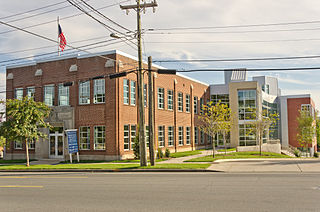
Grinnell Company-General Fire Extinguisher Company Complex is a historic factory complex located at Charlotte, Mecklenburg County, North Carolina. It was built in 1929–1930, and consists of a two-story office building and massive tall, one-story Grinnell manufacturing building. The office building is a reinforced concrete structure, with a brick veneer, a flat roof, and a parapet capped in concrete coping. The manufacturing building has a poured concrete slab foundation, brick veneered walls, a steel framing system consisting of I-beam piers and heavy Pratt truss roof, banks of continuous, steel sash windows, and large, sawtooth monitors. The complex was built for the largest manufacturer of automatic sprinklers and other fire protection products in North America.

Asheboro Hosiery Mills and Cranford Furniture Company Complex, also known as Cranford Industries and National Chair Company, is a historic textile mill and furniture factory complex located at Asheboro, Randolph County, North Carolina. The complex includes three brick industrial buildings erected from 1917 through the 1940s and the Cranford Industries Office, constructed in 1925. Also on the property are the contributing Cranford Industries Smokestack built in the 1950s and a lumber shed erected in the late-1950s.

Acme-McCrary Hosiery Mills, also known as Acme Hosiery Mills, McCrary Hosiery Mills, and Asheboro Grocery Company, is a historic textile mill complex located at Asheboro, Randolph County, North Carolina. The complex includes six buildings and a smokestack, erected between 1909 and 1962. The mill buildings were designed by architect Richard C. Biberstein and the oldest section is a two-story, heavy-timber-frame mill with load bearing brick walls. The Acme-McCrary-Sapona Recreation Center was built in 1948–1949, and is a two-story, Art Moderne style brick recreation center. The buildings were added to the National Register of Historic Places in 2014.
Morse and Wade Building, also known as the Yadkin Valley Hotel, is a historic commercial building located at East Bend, Yadkin County, North Carolina. It was built about 1890, and is a two-story, brick building on a brick foundation. It has Italianate style design elements including arched window and door openings. The building initially housed the Yadkin Valley Hotel in the east half and the Morse and Wade Store in the west half. From about 1903 to 1940, it housed a tobacco bag factory. It is the oldest known commercial building in East Bend.

H. Lauter Company Complex, also known as J. Solotken Company, Lauter Lofts, and Harding Street Lofts, is a historic factory complex located at Indianapolis, Indiana. It was built between 1894 and 1912, and includes the South Factory, the North Factory, and the Office Building. The factory buildings are in the Italianate and the office building is in the Classical Revival style. The North Factory is a four-story brick building with a raised full basement constructed sometime between 1908 and 1912. The Office Building is a two-story brick building constructed between 1899 and 1908 and has a truncated hipped roof. The four-story, U-shaped core of the South Factory was built in two phases; the eastern portion between 1894 and 1898 and the western portion in 1899. The H. Lauter Company furniture manufacturer began in 1894 and they continued to operate at the location until 1936. The buildings have been converted to condominiums and apartments.

The Klingman Lofts is a former industrial building that has been converted to residential use, located at 400 Ionia Avenue SW, in Grand Rapids, Michigan. It was built in stages, beginning in 1895, as a furniture factory, and was formerly known as the Central Furniture Company Factory and the H.E. Shaw Furniture Company Factory. It was listed on the National Register of Historic Places in 2013. The building was renovated into apartment space in 2015.






















